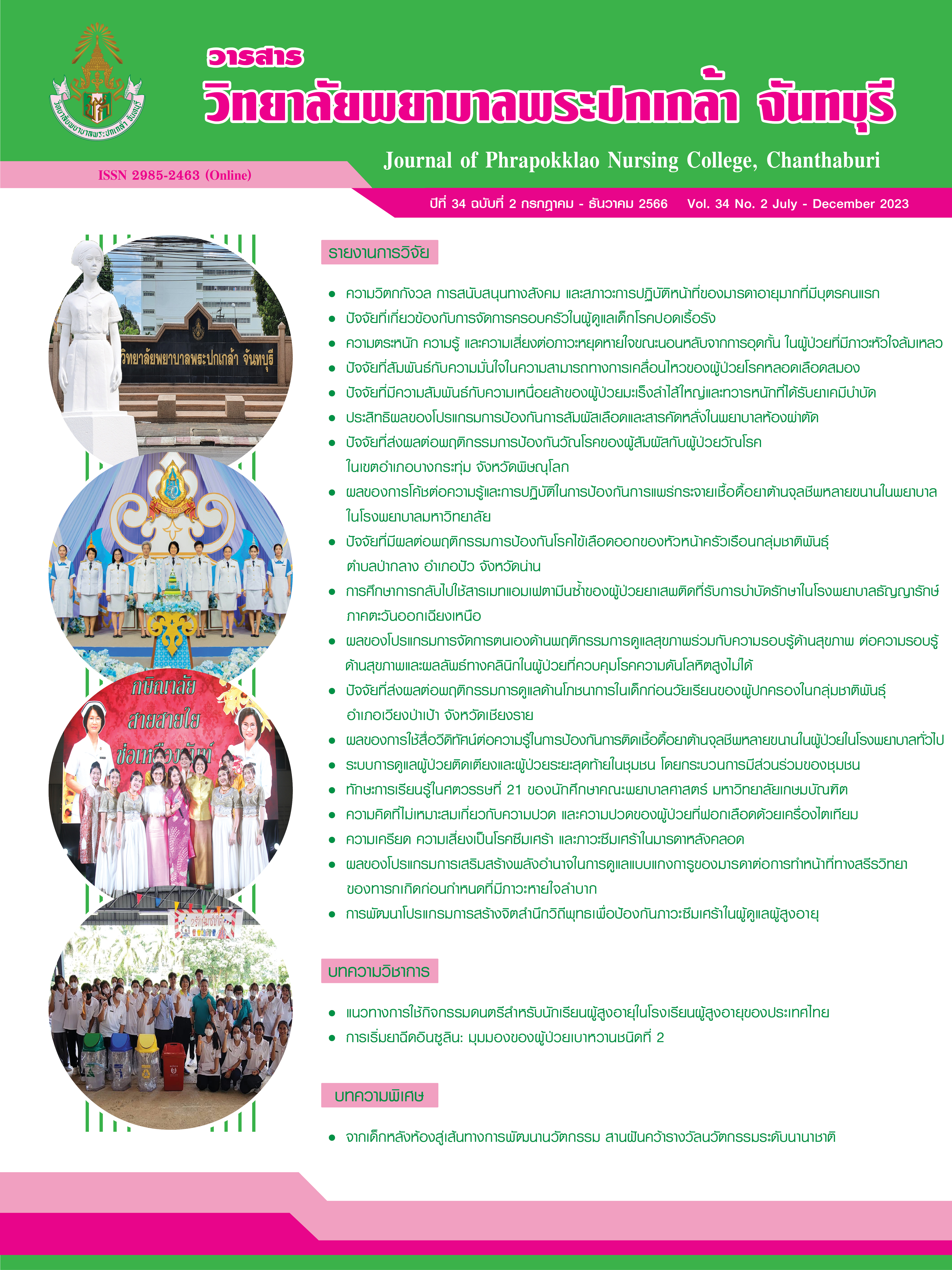Effectiveness of the Blood and Body Fluid Exposure Prevention Program among Operating Room Nurses
Keywords:
Program, Prevention, Blood and body fluid exposure, Operating room nursesAbstract
This quasi-experimental research aimed to study the effectiveness of the blood and body fluid exposure (BBFE) prevention program among operating room nurses. The samples consisted of 36 operating room nurses in a university hospital. The research instruments included the BBFE prevention program among operating room nurses, the demographic questionnaire, the knowledge on BBFE prevention test with a reliability of .73, the practice on BBFE prevention observation form with a reliability of 1, and the incidence of BBFE record form. The implementation and data collection were conducted from November 2020 to January 2021. Data were analyzed by frequency, percentage, mean, standard deviation, median, quartile, Wilcoxon signed-rank test, Chi-square test, and calculating incidence.
The research results revealed that 1) after using the program, operating room nurses had statistically significantly higher score of knowledge on BBFE prevention than that of before using the program (Z = -4.851, p < .001); 2) after using the program, operating room nurses had statistically significantly higher proportion of correct practice on BBFE prevention than that of before using the program (χ2 = 247.956, p < .001); and 3) after using the program, operating room nurses had lower incidence of BBFE than that of before using the program.
This research suggests that nurse executives should provide knowledge, demonstration and return demonstration, feedback, and personal protective equipment to operating room nurses. This will help operating room nurses improve their knowledge and practice on BBFE prevention.
References
ทิศนา แขมมณี. (2564). ศาสตร์การสอน: องค์ความรู้เพื่อการจัดกระบวนการเรียนรู้ที่มีประสิทธิภาพ (พิมพ์ครั้งที่ 25). กรุงเทพฯ: สำนักพิมพ์แห่งจุฬาลงกรณ์มหาวิทยาลัย.
นงค์คราญ วิเศษกุล. (2562). การพัฒนาสื่อการเรียนการสอนทางการพยาบาล: แนวคิดและการประยุกต์ใช้. เชียงใหม่: โชตนาพริ้นท์.
นงเยาว์ เกษตร์ภิบาล. (2561). ความปลอดภัยในการผ่าตัด. เชียงใหม่: โชตนาพริ้นท์.
ศักรินทร์ ชนประชา. (2557). ทฤษฎีการเรียนรู้ผู้ใหญ่: สิ่งที่ครูสอนผู้ใหญ่ต้องเรียนรู้. วารสารศึกษาศาสตร์ มหาวิทยาลัยสงขลานครินทร์ วิทยาเขตปัตตานี, 25(2), 13–23.
สุคนธา วัฒนพงษ์, จิตตาภรณ์ จิตรีเชื้อ, และนงเยาว์ เกษตร์ภิบาล. (2559). ผลของหลายกลยุทธ์ต่อการปฏิบัติการป้องกันและอุบัติการณ์การสัมผัสเลือดและสารคัดหลั่งของพยาบาลห้องคลอด. พยาบาลสาร, 43(2), 57–67.
สุวัฒน์ วัฒนวงศ์. (2555). จิตวิทยาเพื่อการฝึกอบรมผู้ใหญ่ (พิมพ์ครั้งที่ 3). กรุงเทพฯ: เอ็กซเปอร์เน็ท.
Association of periOperative Registered Nurses (AORN). (2017). Recommended practices for sharps safety. In AORN, Guidelines for perioperative practice 2017 (pp. 425–440). Denver, CO: AORN Inc.
Burns, N., & Grove, S. K. (2005). The practice of nursing research: Conduct, critique, and utilization (5th ed.). St. Louis, MO: Elsevier Saunders.
Centers for Disease Control and Prevention. (2015). Sharps safety for healthcare settings. Retrieved from https://www.cdc.gov/sharpssafety/
Cooke, C. E., & Stephens, J. M. (2017). Clinical, economic, and humanistic burden of needlestick injuries in healthcare workers. Medical Devices: Evidence and Research, 10, 225–235. doi:10.2147/MDER.S140846
Goldrick, B. A., & Turner, J. G. (1995). Education and behavior change in prevention and control of infection. In B. M. Soule, E. L. Larson, & G. A. Preston (Eds.), Infections and nursing practice: Prevention and control (pp. 175–192). St. Louis: Mosby.
Green, L. W., & Kreuter, M. W. (2005). Health program planning: An educational and ecological approach (4th ed.). New York: McGraw-Hill.
Kasatpibal, N., Whitney, J. D., Katechanok, S., Ngamsakulrat, S., Malairungsakul, B., Sirikulsathean, P., … Muangnart, T. (2016a). Practices and impacts post-exposure to blood and body fluid in operating room nurses: A cross-sectional study. International Journal of Nursing Studies, 57, 39–47. doi:10.1016/j.ijnurstu.2016.01.010
Kasatpibal, N., Whitney, J. D., Katechanok, S., Ngamsakulrat, S., Malairungsakul, B., Sirikulsathean, P., … Muangnart, T. (2016b). Prevalence and risk factors of needlestick injuries, sharps injuries, and blood and body fluid exposures among operating room nurses in Thailand. American Journal of Infection Control, 44(1), 85–90. doi:10.1016/j.ajic.2015.07.028
Knowles, M. S. (1980). The modern practice of adult education: From pedagogy to andragogy. New York: Cambridge, The Adult Education.
Lin, H., Wang, X., Luo, X., & Qin, Z. (2020). A management program for preventing occupational blood-borne infectious exposure among operating room nurses: An application of the PRECEDE-PROCEED model. Journal of International Medical Research, 48(1), 1–12. doi:10.1177/0300060519895670
Osta, A., Vasli, P., Hosseini, M., Nasiri, M., & Rohani, C. (2018). The effects of education based on the Health Belief Model on adherence to standard precautions among operating room staff. Iranian Red Crescent Medical Journal, 20(Suppl. 1), 1–8. doi:10.5812/ircmj.60112
Polit, D. F., & Beck, C. T. (2017). Nursing research: Generating and assessing evidence for nursing practice (10th ed.). Philadelphia: Wolters Kluwer Health.
Yang, H., Zhang, H., Lu, Y., Gu, Y., Zhou, J., & Bai, Y. (2020). A program to improve the knowledge, attitudes, and practices of needle stick and sharps injuries through bundled interventions among nurses: An KAP mode-based approach to intervention. Psychology, Health & Medicine, 27(1), 1–12. doi:10.1080/13548506.2020.1830132
Downloads
Published
How to Cite
Issue
Section
Categories
License
Copyright (c) 2023 Journal of Phrapokklao Nursing College, Chanthaburi

This work is licensed under a Creative Commons Attribution-NonCommercial-NoDerivatives 4.0 International License.
เนื้อความ ข้อมูล และรายการอ้างอิงที่ผู้เขียนใช้ในการเขียนบทความเพื่อลงตีพิมพ์ในวารสารวิทยาลัยพยาบาลพระปกเกล้า จันทบุรี ถือเป็นความคิดเห็นและความรับผิดชอบของผู้เขียน คณะผู้จัดทำวารสารไม่จำเป็นต้องเห็นพ้องด้วยหรือร่วมรับผิดชอบ
บทความที่ได้รับการลงตีพิมพ์ในวารสารวิทยาลัยพยาบาลพระปกเกล้า จันทบุรี ถือเป็นลิขสิทธิ์ของวารสารวิทยาลัยพยาบาลพระปกเกล้า จันทบุรี หากหน่วยงานหรือบุคคลใดต้องการนำส่วนหนึ่งหรือทั้งหมดของบทความไปเผยแพร่ต่อเพื่อวัตถุประสงค์ใด ๆ จะต้องได้รับอนุญาตจากบรรณาธิการวารสารก่อน



